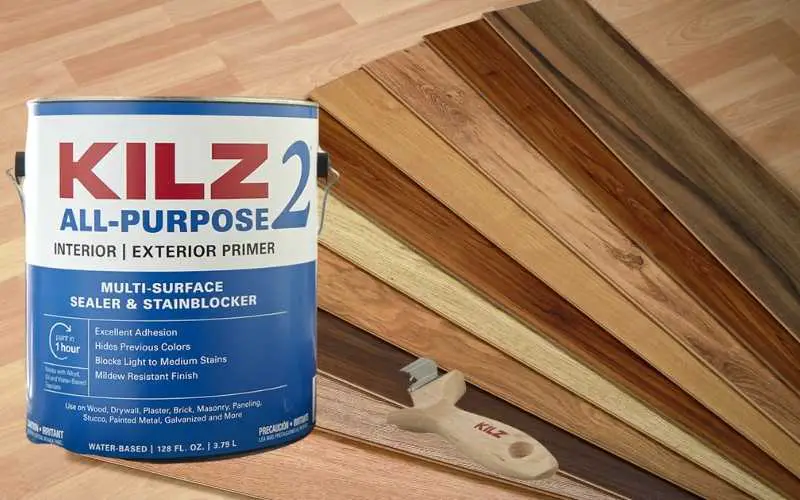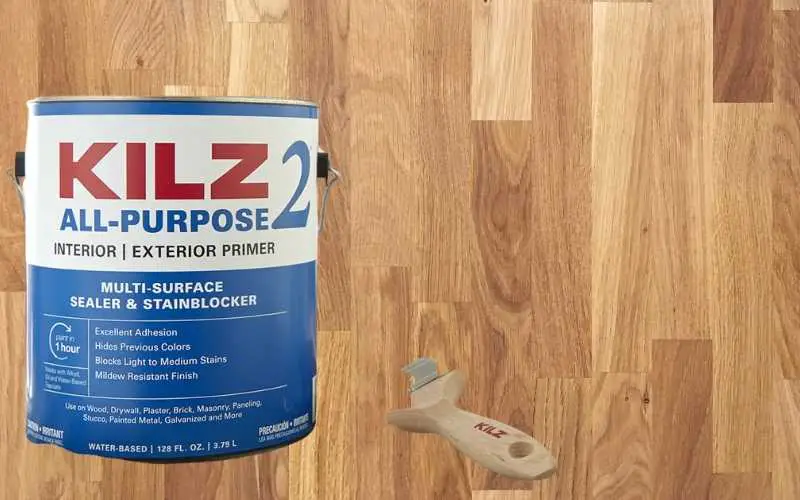Kilz is a unique product that surpasses other products in people’s minds when they think of painting an area that contains an uneven surface or even moisture.
However, the package is quite particular about not using Kilz on flooring. We didn’t understand why at first, and you probably don’t too, and that’s why you’re here.
So, why is Kilz not recommended for flooring? The major reason is because Kilz doesn’t have the glossy finish associated with most floor finishes and cannot survive the heavy usage and high foot traffic of floors.
Read on as we throw more light on it.
Related: Best Mold and Mildew Resistant Exterior Paint
What is Kilz?
Table of Contents
Kilz is a popular primer paint that is normally oil-based, making it very thick. Kilz prevents bleed through, especially on porous surfaces.
It hides stains and removes odors and other imperfections on the surface.
Why is Kilz Not Recommended for Flooring?
The major reason is that Kilz doesn’t have the glossy finish associated with most floor finishes.
A primer coating is typically designed with flat or no-sheen, which means that kiln dries to form a textured layer. It cannot survive the heavy usage and high foot traffic of floors.
Asides from that, and funny enough, Kilz is made as a seal for odors, and it has a strong odor of its own which isn’t very attractive and can last for four days.
This is another disadvantage of using Kilz inside the home. The product is paint, part sealant, and part adhesive, so it’s not strange to have a strong smell.
The more ventilated the area is, the higher the chances that the odor will start to diffuse. If you notice that the odor of paint makes it difficult for you to breathe as you should, you can always wear personal protective equipment.
Knowing all this, what happens when you use Kilz on flooring?
What Happens When Kilz is Used on Flooring?
Kilz is a primer coating, so it has amazing adhesive qualities. When applied, it sticks to the floor properly.
However, as I said earlier, Kilz is not glossy, unlike most floor finishes, so it cannot protect your floor as much.
This makes the floor prone to dust nibs, dents, and damage from foot traffic and heavy use.
Besides the poor floor protection, Kilz will offer you, is impressive in hiding stains, filth, and imperfections because that is what it’s made to do. So while it may cause damage, it hides stains pretty well.
Kilz could be used as an undercoat for a floor finish. It could be used on some types of floors, though. Like what, you ask?
Read: What Is the Cheapest Way to Refinish Hardwood Floors?
Type of Floors Kilz Can Be Used
Kilz primer can be used on floors that are strong and durable. Why? These floors don’t need much protection from the primer; they’re already strong and can withstand heavy foot traffic.
However, this is not so straightforward, and you will understand as we go on. These floors are:
Tiled floors
Kilz can be applied on tiles because they are strong enough to protect themselves from the usage that comes with indoor floors.
They are also moisture resistant. However, Kilz will not stay on for long as they will not adhere well to the tiled floor since ceramic tiles are usually slick and non-porous.
Concrete Floors
Concrete is a mixture of cement, sand, gravel, and water which hardens over time. It is very strong and durable by design and can’t be damaged easily, so using a Kilz is a good idea.
However, you should be made aware that Kilz wouldn’t dry to form a glossy layer on your concrete.
Rather, the Kilz coating will become textured, which can be easily stained. So, you will need frequent cleaning of the floors.
Subfloors
This is one of the types of flooring that Kilz primer is designed for. Subfloors are the base for floor finishes, and using Kilz primer on the subfloor will prep it well.
However, you must apply a final coat over the Kilz if you use it on the subfloor.
These are the floors that Kilz can use, but with these reasonable precautions. There are some floors Kilz shouldn’t be used on at all. Before you ask, keep reading.
Floors That Kilz Cannot Be Used
Please note that Kilz can be used on the listed types of floors below but only as a coating for preparation.
We do not recommend the usage of Kilz primer as a final coat or finishing coat on the said floors because these floors are not strong enough to survive heavy use and foot traffic without a tough topcoat.
Wooden Floors
Do not use Kilz on wooden floors because it cannot protect them from moisture, and we all know moisture on wood causes rot.
Kilz primer on wood will also prevent the finish coat, especially wood stains, from penetrating and sticking properly to the wood.
Finished Floor
Kilz shouldn’t be used on finished floors unless you want to put on a new finish. When applied to a finished floor, it will not adhere to the floor adequately.
Any existing finish on the floor will prevent good enough adhesion between the Kilz coating and the floor, reasonably so.
Read: Matte vs Satin Finish Hardwood Floors
Conclusion
To summarize, Kilz is a primer coating, not a floor finish, and for this reason, it is not recommended for flooring. It cannot protect the floors from heavy usage, dents, or moisture.
We do not recommend the usage of Kilz primer as the final coat over delicate exterior floorings.
If you are to use Kilz over any type of floor, it should only be used before applying a final coat of floor finish.
We believe this information has helped you see what floors you can and can’t use Kilz for and what to watch out for when you do use it.
Kilz products are very helpful as long as you use them the right way. Lastly, we implore you to please share it across your entire social media pages.

